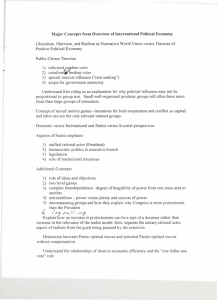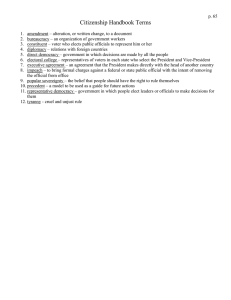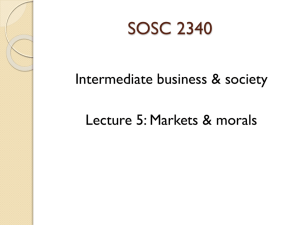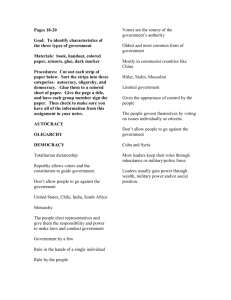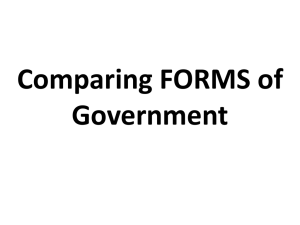I. The Logic of Government Failure
advertisement
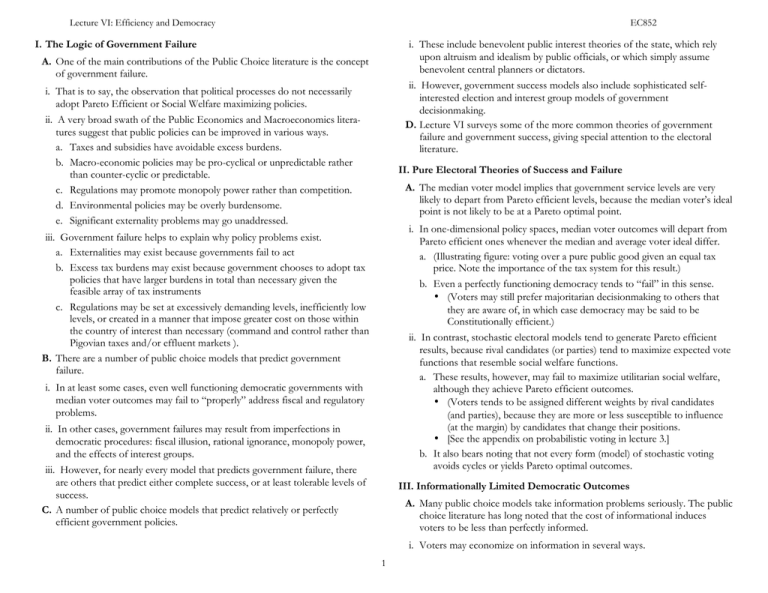
Lecture VI: Efficiency and Democracy EC852 I. The Logic of Government Failure i. These include benevolent public interest theories of the state, which rely upon altruism and idealism by public officials, or which simply assume benevolent central planners or dictators. A. One of the main contributions of the Public Choice literature is the concept of government failure. ii. However, government success models also include sophisticated selfinterested election and interest group models of government decisionmaking. D. Lecture VI surveys some of the more common theories of government failure and government success, giving special attention to the electoral literature. i. That is to say, the observation that political processes do not necessarily adopt Pareto Efficient or Social Welfare maximizing policies. ii. A very broad swath of the Public Economics and Macroeconomics literatures suggest that public policies can be improved in various ways. a. Taxes and subsidies have avoidable excess burdens. b. Macro-economic policies may be pro-cyclical or unpredictable rather than counter-cyclic or predictable. c. Regulations may promote monopoly power rather than competition. d. Environmental policies may be overly burdensome. e. Significant externality problems may go unaddressed. II. Pure Electoral Theories of Success and Failure A. The median voter model implies that government service levels are very likely to depart from Pareto efficient levels, because the median voter’s ideal point is not likely to be at a Pareto optimal point. i. In one-dimensional policy spaces, median voter outcomes will depart from Pareto efficient ones whenever the median and average voter ideal differ. a. (Illustrating figure: voting over a pure public good given an equal tax price. Note the importance of the tax system for this result.) b. Even a perfectly functioning democracy tends to “fail” in this sense. w (Voters may still prefer majoritarian decisionmaking to others that they are aware of, in which case democracy may be said to be Constitutionally efficient.) ii. In contrast, stochastic electoral models tend to generate Pareto efficient results, because rival candidates (or parties) tend to maximize expected vote functions that resemble social welfare functions. a. These results, however, may fail to maximize utilitarian social welfare, although they achieve Pareto efficient outcomes. w (Voters tends to be assigned different weights by rival candidates (and parties), because they are more or less susceptible to influence (at the margin) by candidates that change their positions. w [See the appendix on probabilistic voting in lecture 3.] b. It also bears noting that not every form (model) of stochastic voting avoids cycles or yields Pareto optimal outcomes. iii. Government failure helps to explain why policy problems exist. a. Externalities may exist because governments fail to act b. Excess tax burdens may exist because government chooses to adopt tax policies that have larger burdens in total than necessary given the feasible array of tax instruments c. Regulations may be set at excessively demanding levels, inefficiently low levels, or created in a manner that impose greater cost on those within the country of interest than necessary (command and control rather than Pigovian taxes and/or effluent markets ). B. There are a number of public choice models that predict government failure. i. In at least some cases, even well functioning democratic governments with median voter outcomes may fail to “properly” address fiscal and regulatory problems. ii. In other cases, government failures may result from imperfections in democratic procedures: fiscal illusion, rational ignorance, monopoly power, and the effects of interest groups. iii. However, for nearly every model that predicts government failure, there are others that predict either complete success, or at least tolerable levels of success. C. A number of public choice models that predict relatively or perfectly efficient government policies. III. Informationally Limited Democratic Outcomes A. Many public choice models take information problems seriously. The public choice literature has long noted that the cost of informational induces voters to be less than perfectly informed. i. Voters may economize on information in several ways. 1 Lecture VI: Efficiency and Democracy EC852 a. First, persons economizing on information may reduce their sample sizes. w This the most natural way of interpreting the MBe vs MCe of information diagrams and equations included in the early Public Choice books of Antony Downs and Gordon Tullock. b. However, as long as the samples remain complete, in the sense that no portion of the sample space is excluded ex ante and complete information is obtained for the observations made, this method of economizing on information does not necessarily produce inefficient outcomes. w Voter expectations remain unbiased as long as “proper” estimation techniques are used. w So, on average voters make the right (utility-maximizing) decisions. c. Second, voters may economize on information by obtaining less than complete information. w That is to say, voters may choose to remain completely uninformed about some policy issues, candidate positions, or other relevant information. w In this case, voters tend to have biased expectations about the consequences of public policies and/or about their own costs and benefits from policies (Congleton 2001). w Ignorance implies that, even if median voter outcomes occur in electoral models, the policies are unlikely to advance the true interests of the median voter. w (In addition to rational ignorance, it bears noting that “natural” ignorance has similar implications.) ii. Fiscal illusion occurs when voters (including the median voter) have systematically biased information about the costs or benefits of programs being voted on and so make systematic mistakes about the policies that "best" advance his or her own interests. a. (Illustration, fiscal illusion in case where marginal costs are under estimated, ala G. Tullock.) b. (Illustration, fiscal illusion in the case where marginal benefits are underestimated, ala A. Downs.) c. Congleton (2001) notes that rational ignorance is a sufficient condition for fiscal illusion. d. Caplan’s work (2001, 2002, 2007) suggests that fiscal illusion may occur because voters are not very interested in obtaining accurate information about public policies. e. The Italian public finance scholars (i.e. Puvianni 1897) suggested the governments often manipulate tax systems to produce fiscal illusion. w They may, for example, use very indirect forms of taxation to make it more difficult to assess the true cost of public programs. w By increasing the cost of information, they reduce the amount of information acquired by all persons, including voters. iii. The extent and importance of the information problems confronted by voters is much debated in the “government failure” literature. a. The existence of fiscal illusion and/or rational ignorance is much emphasized by proponents of government failure. w In this literature, the more fiscal illusion there is and/or the more rational ignorance, the greater and more likely are government failures--even from the perspective of the median voter. b. Those who are skeptical of government failures note that many informational problems are reduced by the electoral contests. w There are often just two alternatives. w Campaigns, themselves, produce a good deal of information--much of which is useful to voters (Mueller and Stratmann, 1994). w They point out that the relative merits of the alternatives can often be inferred from readily available information [Whittman (1991, 1995), Lupia and McCubbins (1998)]. iv. Given incomplete information, it is also possible that majority rule tends to aggregate information for several reasons. a. Feddersen and Pesendorfer (1996) suggest that only relatively well-informed voters cast votes. b. Benz and Stutzer (2004) suggest that voters tend to be better informed about public policies when they are more engaged in the policy making decisions. w Thus, voters tend to be better informed about public policies when they vote on referenda than when they vote for representatives. c. A very broad range of papers in political science, statistics, and public choice suggest that Majoritarian estimates (of candidate quality or the merits of public policies) tend to be much more accurate than those of any single candidate. v. The Condorcet Jury theorem is often used as a model of information aggregation (or estimation efficiency) in majoritarian models. a. In 1785, Condorcet noted that majority decisions in Juries would tend to reflect the view of moderate jury members. A few jurists might be certain that the person being tried was guilty and few others might be 2 Lecture VI: Efficiency and Democracy b. c. d. e. f. g. EC852 certain that he or she was innocent. The middle jurists would tend to take account of both opinions and so balance the merits of both opinions. The result would be a more accurate decision. In 1907, Galton noted that median estimates tended to be very accurate (at county fairs). (See Levy and Peart (2002) for an overview of Galton’s interest in medians, median estimators, and other issues.) In the 1990s, a number of political scientists noted that Condorcet’s jury theorem implied that elections could be regarded as median estimators with very large samples. w As a consequence, median voter outcomes were (or at least could be) far more accurate than any single voter’s assessment was likely to be. w See for example: Grofman and Feld (1988), McLean and Hewitt (1994), and McLennan (1998). w (For a skeptical assessment of the Condorcet approach, see Goodin and Estlund (2004), or Austin-Smith and Banks (1996).) Most of the Condercet Jury Theorem papers and proofs focused on simple binary choice settings in which there is a “right” and a “wrong” choice. Congleton (2007) examines a setting in which candidate quality had to be estimated using small samples of complete and incomplete information. In his simulations, voter estimates provide the basis for making choices among candidates. w His simulation results demonstrate that the Condorcet-Galton results hold up very well when voter all (or mostly) have complete information, even if they use very small data sets for the purposes of estimation. w However, if some voters are rationally ignorant and thus made biased estimates, the Condorcet-Galton results tend to disappear as the number of ignorant voters increase. w In such cases, electoral results often produced mistakes in the sense that less competent representatives were elected. (Congleton also noted that many features of liberal democracy tend to reduce voter ignorance and may be necessary for democratic decisionmaking to work tolerably well: public education, a free press, freedom of speech, published laws, and think tank studies of policies.) [Some of Congleton’s simulation results are likely to be shown in lecture.] IV. Other Electoral and Non-electoral Theories of Government Failure and Success A. Congleton (2003) suggests that all democracies have to solve three problems to be successful. i. First, democracies have to over come the problems of cycles. w Electoral cycles may prevent policy decisions from being made. w Electoral cycles may lead to policies well outside the Pareto set to be adopted, undermining support for democracy. ii. Second, democracies have to avoid the problem of excessive redistribution that can lead to a poverty trap. w See the figure below, or the Melzer Richard model in the previous lecture. iii. Third, democracies have to solve the problem of the next election. Figure 2 The Normative Escape from the Transfer Poverty Trap MC = ( 1-t)Yt - Y - Ut/ UC - Tn 3 T* 100 Lecture VI: Efficiency and Democracy EC852 w Officeholders in wealthy states have little incentive to hold the next election, because they might lose. w Former majorities may also benefit if the next election is cancelled insofar as their representatives faithfully advance the interest of their past supporters. iv. Buchanan and Tullock (1962) also point out that the majority has no obvious reason to internalize the external costs that it's decisions impose on the minority. w Thus, the same sorts of externality problems that can cause markets to depart from Pareto efficiency may also be associated with public policy choices. B. Many interest group models also imply that government policies fail to advance either the median voter’s and/or the general (average) interest. C. There may be principal agent problems between voters and both their elected representatives and the bureaucracy. a. The bureaucracy may make “all or nothing” offers to secure larger than efficient budgets because of their informational advantages about the true cost of government programs and/or policy alternatives. b. See Niskanen (1971) and Breton and Wintrobe (1975). D. In many of these cases, however, there are also interest group models that suggest that public policies, nonetheless, advance broad public interests. w Interest group competition may lead to efficient outcomes (Becker 1983). w Institutions may be able to solve principal agent problems in the bureaucracy (Breton and Wintrobe 1975, Weingast and Moran 1983, Banks and Weingast 1992) E. Thus, it can be argued that the existence of government failure is really an empirical question. i. We will take up interest groups in the next part of the course. A brief overview of results relevant for the government failure and government success literature is provided below. V. Evidence of the (Relative) Efficiency of Democracy ii. Olson (1965) suggests that groups with relatively concentrated and large (net) benefits have an easier time organizing to lobby Congress than groups with relatively diffuse and small benefits. a. This tends to bias public policies away toward “special” interests and away from general or average interests. b. For example, many agricultural groups gain substantial trade "protection" at the expense of much larger groups of consumers who lose more than the interest groups gain. w (Examples include the sugar, peanut, tobacco, and dairy industries.) A. Evidence from Switzerland i. Eli Noam (1980) suggests than in many (most) cases the majority in Swiss referenda could compensate the minority for their losses. ii. Bruno Frey (1994): Direct democracies spend less and can break the cartels of political parties and elected politicians. iii. Feld and Savioz (1997) suggest that direct democracies acheive better performance than representative democracies (e.g. those which do not face refereda or recall elections). iii. Interest groups may be able to “capture” control of regulatory agencies and use them to advance their own interests (Stigler 1972). iv. Frey and Stutzer (2000): Citizens are happier in direct democracies. B. Evidence from the US: w Holcombe (1980) finds the counties that are required to have referenda whenever school budgets are increased tend to spend less on public education than when they are not. (E.g. direct democracy spends less on education than representative democracy.) w Matsusaka (2008) demonstrates that initiatives and referenda led to significant tax and expenditure cuts over the last 30 years and that these cuts were supported by a majority of citizens. w He concludes that, by and large, direct democracy in the United States has worked for the benefit of the many rather than the few. C. There is also a good deal of evidence that representative democracies are (and have long been) freer and more prosperous than dictatorships. Table 1 below includes a list of the 25 highest per capita income countries. Table 2 iv. Regional interest groups may exploit the fact that local and regional projects can often be financed using national tax revenues. a. This potentially allows “too many” local projects with negative net benefits. b. Such problems are often referred to as the pork barrel and/or fiscal commons problem. v. Interest groups may be able to "fool" voters into voting for programs that are not truly in their interests by subsidizing favorable information while "taxing" unfavorable information. w That is to say, the informational campaigns sponsored by interest groups may induce fiscal and “regulatory” illusion. 4 Lecture VI: Efficiency and Democracy EC852 includes a list of the 25 lowest per capita income countries. Note that the countries in table 1 tend to be more democratic and have higher civil liberties, more economic freedom, and less corruption than in table 2. 20 21 22 23 24 25 Table 1 The World’s Highest Income Countries and Indices of Their Political and Economic Liberalism Rank Per Capita GDP 1 2 3 4 5 6 7 8 9 10 11 12 13 14 15 16 17 18 19 Country Civil Liberties Index Economic Freedom Rank Corruption Rank Luxembourg Norway Singapore United States Ireland Switzerland Austria Netherlands Iceland Sweden Denmark Canada Australia Belgium Finland UK Japan France Germany 1 1 4 1 1 1 1 1 1 1 1 1 1 1 1 1 2 1 1 15 28 2 6 4 9 23 12 14 26 8 7 3 20 17 10 19 64 25 11 14 4 18 16 5 12 7 7 1 1 9 9 18 5 16 18 23 14 Greece Spain Eq. Guinea Italy Cyprus ( k) Slovenia 2 1 7 2 1 1 1.48 81 29 142 76 24 68 29.28 57 28 171 55 31 26 23.04 Ave The GDP per capita rankings (using purchasing power parity international dollars) come from the World Development Indicators database (2008) assembled by the World Bank. Civil liberty data from the Freedom House 2009 website (downloaded June 2009), economic freedom rankings from the Heritage Foundation’s 2009 Index of Economic Freedom (downloaded July 2009), and corruption rankings from the 2008 Corruption Perceptions Index (downloaded from Transparency International’s website July 2009). Table 2 The World’s Lowest-Income Countries and Indices of Their Political and Economic Liberalism Country Rep. of Congo Burundi Liberia Guinea-Bissau Eritrea Niger Sierra Leone 5 Per Capita GDP Rank Civil Liberties Index Economi c Freedom Rank Corrupti on Rank 1 2 3 4 5 6 7 5 5 4 4 6 4 3 166 153 157 165 175 128 158 158 158 138 158 126 115 158 Lecture VI: Efficiency and Democracy CAR Malawi East Timor Ethiopia Mozambique Togo Rwanda Madagascar Uganda Nepal Mali Burkina Faso Guinea Comoros Tanzania Gambia Bangladesh Haiti Average 8 9 10 11 12 13 14 15 16 17 18 19 20 21 22 23 24 25 EC852 5 4 3 5 3 5 5 3 4 4 3 3 5 4 3 4 4 5 4.12 156 129 149 135 113 154 124 73 63 133 114 85 144 172 93 112 160 147 134.32 i. Pareto (1912) suggests that a social state is clearly inefficient if a change can be made that makes at least one person better off and no one worse off. 151 115 145 126 126 121 102 85 126 121 96 80 173 134 102 158 147 177 131.84 ii. Wicksell (1896) suggests that public policies clearly improve whenever essentially unanimous agreement can be reached concerning the adoption new policies. That is to say, inefficiency can be directly observed by putting policies to a vote. iii. Efficiency from these points of view may be said to arise when there no such changes are possible (e.g. when there are no feasible Pareto superior moves). w Under the Pareto criteria, a move that makes one person worse off can not be considered a Pareto superior move. w (It is interesting to note that Pareto, himself, was a utilitarian.) B. Utilitarian Efficiency and Wealth Maximization. The main rival to the Paretian norms are normative theories that are more or less grounded on Utilitarian ideas about social welfare. i. The utilitarian/social welfare maximization approach are partly consistent with those of the Wicksell and Pareto, insofar as the welfare of every individual counts. Utilitarians agree that any change that makes one person better off without making another worse off, increases “social welfare.” ii. However, the social welfare maximization approach ranks policy alternatives in a quite different manner from that of the Pareto and Wicksellian approaches in other cases. Utilitarians make (or at least allow the possibility of) welfare tradeoffs among individuals. a. Under utilitarian approaches, a move that harms one person can increase social welfare, because the gains realized by the “winners” may be “larger” than the losses born by the losers. b. W is a social welfare function, Ui is the utility level of the ith individual, and WUi > 0 for all i. It is clearly possible that W (U1', U2', U3', ...) > W ( U1 ", U2", U3" ...) even if U1' < U1". c. However, because utilitarian social welfare functions include positive weights for all individuals, the policies recommended by utilitarians turn out to be Pareto (and Wicksellian) efficient. The GDP per capita rankings (using purchasing power parity international dollars) are computed from World Development Indicators (2008) data base assembled by the World Bank. The civil liberties data come from the Freedom House 2009 website (downloaded June 2009), economic freedom rankings from the Heritage Fund’s 2009 Index of Economic Freedom (downloaded July 2009), and corruption rankings from the 2008 Corruption Perceptions Index (downloaded from Transparency International’s website July 2009). iii. Benefit-cost analysis, the compensation principle, and ranking of countries by per capita income can be regarded as variations of the utilitarian approach. C. The contractarian approach. The contractarian approach is similar to the Paretian and Wicksellian approach in many respects, although it also is surprisingly compatible with utilitarian analysis. VI. Appendix on Welfare Economics: What does it mean to say that a democratic polity is efficient? A. Pareto Efficiency and Wicksellian Efficiency. The narrowest and probably most widely used interpretation of economic efficiency are those proposed by Vifredo Pareto and Knut Wicksel at the turn of the last century. 6 Lecture VI: Efficiency and Democracy EC852 i. Contractarians regard improvements to be a matter of negotiating new social contracts. State A is better than State B if all affected parties would agree to sign a contract moving them from A to B. a. Societies and social states are analyzed as contracts that are only necessarily understood by the participants. w But generally, contractarians expect to be able to use contract based reasoning to determine which forms of government, etc., work the best. b. Although not essential to the contractarian approach, contractarians often conduct their analyses from behind veils “of ignorance” (Rawls, 1958, 1971, 1999), or “of uncertainty” (Harsanyi 1955, Buchanan and Tulluck 1962). w In these settings, individuals do not know who a particular constitutional or policy reform will affect their interests, and so have to take account of a broad range of possibilities. w In many cases, the resulting expected utility maximization resembles a Benthamite social welfare function, although the logic behind the mathematics is quite different. w Maximize Ue = ΣUiPi where Pi is the probability of being in person i’s circumstance and Ui is the utility of that circumstance. D. Other approaches to ranking states of the world (normative theories) are also used by philosophers and political scientists, but these are not very widely used by economists. w That is to say, an institution that fails to achieve Pareto efficient results may none-the-less be the best that can be obtained given the range of alternatives known to be available. w This might be said of both representative democracy and competitive markets. i. For example, one might rank existing institutions (and policies) according to patterns of emigration (better countries attract emigrants from lessor countries), or civil liberties. ii. One might use potential for personal development as an index (Sen 1999, 1995). E. Feasibility. i. The three mainstream normative approaches are clearly constrained as a practical matter to choosing policies or institutions that are feasible. w That is to say, although each of these normative theories can rank alternatives that can never be implemented, genuine reforms are limited to what can actually be done. w It is from this perspective that statements like “democracy is the very worst form of government, except for all the rest” make sense. ii. The requirement of feasibility implies that institutions and alternative policies have to be ranked relative to real alternatives, rather than compared to idealized alternatives. 7
